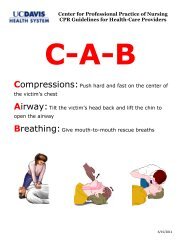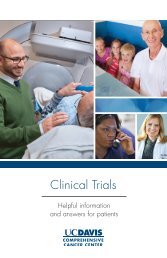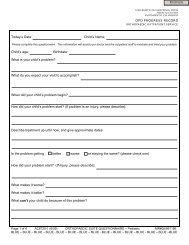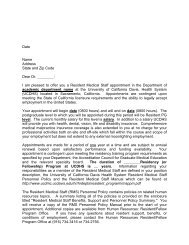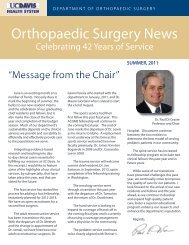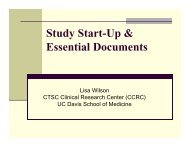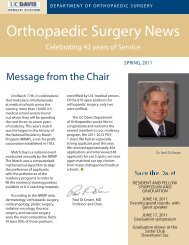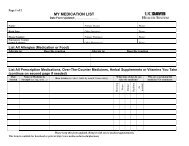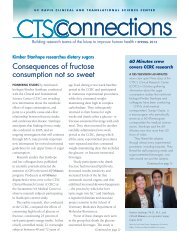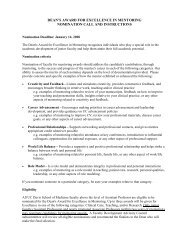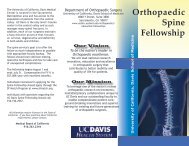Resident Handbook - UC Davis Health System
Resident Handbook - UC Davis Health System
Resident Handbook - UC Davis Health System
- No tags were found...
Create successful ePaper yourself
Turn your PDF publications into a flip-book with our unique Google optimized e-Paper software.
• Suspected Child Abuse: (physical, emotional, neglect, etc.): A telephone report isrequired immediately or as soon as practically possible to the Child Protective ServicesAgency of Shasta County, and a follow-up written report is to be made within 36 hours.• Suspected Dependent Adult/Elder Abuse: (physical, neglect, abandonment, fiduciary,etc.): A telephone report is required immediately or as soon as possible to the AdultProtective Services Agency of Shasta County, and a follow-up report is to be madewithin two (2) working days.• Suspected Violent Injury: (homicide, assault, gunshot, stab wound, choking, lacerations,bruises, etc): A telephone report of previously unreported injuries must be madeimmediately or as soon as practically possible to the law enforcement agency (i.e. police)in the jurisdiction in which the injury occurred, and a follow-up written report is to bemade within two (2) working days.Note that simple, standardized forms are available in the family health center (MFHC) for use infulfilling the written reporting requirements described above.• Reportable Diseases and Conditions: (communicable diseases, STDs, Hepatitis, TBC,etc.): Telephone, fax and/or written reporting of certain diseases to the Shasta CountyPublic <strong>Health</strong> Department are mandated. A reporting form is available in each familyhealth center and in the hospital that delineates the specific reportable diseases andprovides a listing of the required reporting modes (e.g. some diseases require immediatetelephone reports, other require reports by phone and by mail, etc.).Page 151 of 153SURGICAL ASSISTING POLICYThe ACGME requires programs to “provide all residents with training in basic surgicalprinciples and technical skills to assist the surgeon in the operating room.” One of the ways theprogram provides this training is by having residents assist in the surgeries for surgeons whoprecept at MFHC. These patients may or may not be seen at MFHC for their primary care. Theorder of priority for determining which resident will prove this service is as follows:1. <strong>Resident</strong> who may be providing primary care for that patient2. <strong>Resident</strong> on surgical rotation3. FPS resident if not the only senior covering inpatient servicesAt times, the program may not be able to identify a resident who is available to assist surgeonsoperating on patients not seen at MFHC. The clinic manager or clinic director will make thefinal determination.But when patients who do receive their primary care at MFHC are referred for surgery, thesepatients are the responsibility of the clinic. A surgical assistant will be located using thefollowing order of priority:4. Primary care provider for that patient5. <strong>Resident</strong> on surgical rotationC:\Documents and Settings\dhutak\Desktop\rshb13.doc




